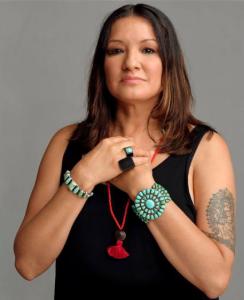Today lets talk about Sandra Cisneros Biography: Sandra Cisneros was born on December 20, 1954, in Chicago, Illinois, to a Mexican father, Alfredo Cisneros de Moral, and a Mexican-American mother, Elvira Cordero Anguiano. She was the only daughter among seven children, a circumstance that would profoundly shape her perspective on gender, family dynamics, and identity throughout her literary career.
Her father worked as an upholsterer, and the family frequently moved between Chicago and Mexico City to visit her paternal grandmother. This constant movement between two countries and cultures created a sense of displacement and cultural duality that would become central themes in her writing. The family lived in various predominantly Latino neighborhoods in Chicago, including Humboldt Park and later the North Side.
Growing up as the only girl with six brothers meant that Sandra often felt isolated within her own family. Her mother, recognizing her daughter’s need for intellectual stimulation and understanding her position as the sole female child, encouraged Sandra’s love of reading and writing. This support proved crucial in nurturing her literary aspirations during a time when few Chicana voices were represented in American literature.
Sandra Cisneros Biography
Sandra Cisneros Education and Literary Formation
Cisneros attended Josephinum Academy, a Catholic all-girls school, where she first began to develop her writing skills seriously. The environment of an all-female institution provided her with confidence and encouraged her intellectual development in ways that might not have been possible in a co-educational setting during that era.
She went on to earn her Bachelor of Arts degree in English from Loyola University Chicago in 1976. During her undergraduate years, she began to explore creative writing more seriously, though she often felt disconnected from the predominantly white, middle-class perspectives that dominated her literature courses. This sense of alienation would later fuel her determination to create literature that reflected the experiences of people from her own community.
The pivotal moment in her literary development came when she pursued a Master of Fine Arts degree at the prestigious Iowa Writers’ Workshop, which she completed in 1978. At Iowa, she found herself surrounded by students from privileged backgrounds whose experiences seemed foreign to her own. It was during a graduate seminar discussion about the house as a symbol in literature that she experienced a revelation. While her classmates spoke of houses as symbols of security and family heritage, Cisneros realized that her own experience of housing was fundamentally different—characterized by instability, poverty, and shame rather than pride and permanence.
This moment of recognition became the catalyst for her most famous work. She began to understand that her experiences as a Chicana from a working-class family were not only valid literary material but essential voices that had been largely absent from American literature.

Sandra Cisneros Early Career and “The House on Mango Street”
After completing her MFA, Cisneros worked various jobs while developing her craft. She served as a teacher and counselor for high school dropouts, worked as an arts administrator, and taught creative writing. These experiences kept her connected to the Latino community and provided rich material for her writing.
Her breakthrough came with the publication of “The House on Mango Street” in 1984 by Arte Público Press. The novella, written in a series of interconnected vignettes, tells the story of Esperanza Cordero, a young Chicana girl growing up in a Latino neighborhood in Chicago. The work was revolutionary in its approach, combining poetic language with accessible storytelling to create a unique voice that spoke to both literary audiences and readers who rarely saw their experiences reflected in literature.
“The House on Mango Street” drew heavily from Cisneros’s own childhood experiences, though she emphasized that it was not strictly autobiographical. The book explored themes of poverty, racism, sexism, and the struggle for self-identity within the constraints of cultural expectations. What made the work particularly groundbreaking was its focus on a young Latina protagonist who dreams of escaping her circumstances while remaining connected to her cultural roots.
The book initially received modest attention but gradually gained recognition through word-of-mouth and classroom adoption. It eventually became one of the most widely taught books in American high schools and universities, introducing millions of students to Chicana literature.
Sandra Cisneros Literary Recognition and “Woman Hollering Creek”
Following the success of “The House on Mango Street,” Cisneros continued to develop her distinctive literary voice. She published her first poetry collection, “My Wicked, Wicked Ways,” in 1987, which further established her reputation as an important new voice in American literature.
Her second major prose work, “Woman Hollering Creek and Other Stories,” was published by Random House in 1991, marking her transition to a major commercial publisher. This collection of short stories expanded on the themes introduced in her earlier work, exploring the lives of Chicana women across different ages and circumstances. The stories dealt with issues of domestic violence, cultural displacement, economic hardship, and the complex relationships between Mexican and American identities.
The title story, “Woman Hollering Creek,” became particularly celebrated for its reimagining of the Mexican legend of La Llorona (the weeping woman). Cisneros transformed this traditional tale of female victimization into a story of empowerment and liberation. The collection earned widespread critical acclaim and won several awards, including the PEN Center West Award for Best Fiction of 1991.
Sandra Cisneros Themes and Literary Style
Throughout her career, Cisneros has been celebrated for her unique literary style that blends elements of poetry and prose. Her writing is characterized by its lyrical quality, use of vernacular speech, and ability to find beauty in everyday experiences. She often employs a technique she calls “writing in the margins”—finding the extraordinary in the seemingly ordinary lives of working-class Latino families.
Her work consistently explores several key themes:
Cultural Identity and Bilingualism: Cisneros frequently incorporates Spanish words and phrases into her English text, creating a bilingual voice that reflects the lived experience of many Latino Americans. This approach was initially controversial but has become recognized as an authentic representation of bicultural experience.
Gender and Machismo: Her work provides unflinching examinations of how traditional gender roles within Latino culture can be both protective and restrictive. She explores the ways women navigate between cultural tradition and personal autonomy.
Class and Economic Struggle: Having grown up in working-class circumstances, Cisneros consistently depicts the realities of economic hardship and the ways poverty shapes family relationships and individual aspirations.
Geography and Belonging: The concept of “home” and “belonging” runs throughout her work, reflecting her own experience of moving between Chicago and Mexico, and the broader immigrant experience of existing between two cultures.
Sandra Cisneros Later Works and Continued Evolution
In 2002, Cisneros published “Caramelo,” a semi-autobiographical novel that represents her most ambitious work to date. The novel traces three generations of a Mexican-American family, drawing on her own family history and the broader experience of Mexican immigration to the United States. The book took her nine years to complete and showcases her evolution as a storyteller, incorporating elements of magical realism alongside realistic family drama.
“Caramelo” was notable for its experimental structure, including footnotes that provided cultural and historical context for readers unfamiliar with Mexican traditions and history. The novel was selected as a notable book by several major publications and was chosen for the “One City, One Book” program in several cities.
She has also continued to publish poetry, including collections such as “Loose Woman” (1994) and “My Wicked, Wicked Ways” (revised edition), which have further established her reputation as a significant poet as well as prose writer.
Sandra Cisneros Teaching and Advocacy
Beyond her creative work, Cisneros has been deeply committed to education and literary advocacy. She has taught creative writing at various institutions, including the University of California, Berkeley, the University of Michigan, and as a visiting writer at numerous colleges and universities.
She has been particularly dedicated to supporting other Latino writers and has served as a mentor to many emerging voices in Chicano literature. Through workshops, speaking engagements, and literary organizations, she has worked to create more opportunities for underrepresented writers to develop their craft and find publication.
Cisneros has also been an advocate for literacy and education in Latino communities. She has supported various educational initiatives and has spoken frequently about the importance of seeing one’s own experience reflected in literature as a way of validating identity and encouraging academic achievement.
Personal Life and Philosophy
Cisneros has been open about her decision to remain childless, a choice that has allowed her to dedicate herself fully to her writing and advocacy work. This decision has sometimes put her at odds with traditional expectations within her cultural community, but she has used her platform to speak about the validity of different life choices for women.
She currently divides her time between San Antonio, Texas, and Mexico, maintaining the bicultural existence that has always informed her work. Her home in San Antonio’s King William Historic District became the center of a controversy in the 1990s when she painted it bright purple, leading to a dispute with the city’s historic preservation board. The incident became symbolic of broader issues about cultural expression and community standards.
Sandra Cisneros Awards and Recognition
Throughout her career, Cisneros has received numerous awards and honors, including:
- Two National Endowment for the Arts Fellowships for Fiction
- The Lannan Literary Award for Fiction
- The American Book Award from the Before Columbus Foundation
- The PEN Center West Award for Best Fiction
- A MacArthur Fellowship (often called the “Genius Grant”) in 1995
- The Texas Medal of the Arts
- Honorary doctorates from numerous universities
In 2016, she received the National Medal of Arts from President Barack Obama, recognizing her contributions to American literature and her role in giving voice to the Latino experience in the United States.
Sandra Cisneros Literary Legacy and Cultural Impact
Sandra Cisneros’s impact on American literature extends far beyond her individual works. She has been instrumental in opening doors for other Latino writers and in establishing Chicana literature as a significant force in American letters. Her success paved the way for subsequent generations of Latino writers to find mainstream publication and academic recognition.
“The House on Mango Street” in particular has had an enormous cultural impact. It has been translated into numerous languages and has introduced millions of readers worldwide to the Chicana experience. The book’s inclusion in educational curricula has made it one of the most widely read works by a Latino author, helping to diversify the canon of American literature taught in schools.
Her work has also influenced other art forms, including theater, film, and visual arts. Several of her stories have been adapted for stage productions, and her influence can be seen in the work of contemporary Latino artists across various media.
Sandra Cisneros Critical Reception and Scholarly Attention
Cisneros’s work has been the subject of extensive academic study and critical analysis. Scholars have examined her use of language, her treatment of gender and cultural identity, and her role in the development of Chicano literature. Her innovative blending of genres and her accessible yet sophisticated prose style have made her work appealing to both popular and academic audiences.
Some critics have noted tensions in her work between accessibility and literary complexity, between cultural specificity and universal themes. However, most scholars agree that these tensions are productive rather than problematic, reflecting the complex position of Latino writers in American literary culture.

Frequently Asked Questions About Sandra Cisneros Biography
When and where was Sandra Cisneros born, and what is her cultural background?
Sandra Cisneros was born on December 20, 1954, in Chicago, Illinois. Although her parents met in Chicago, they were both from Mexico. Her family background reflects the Mexican-American experience, with her mother’s family coming from humble roots tracing back to Guanajuato, Mexico, while her father’s family was considered more “admirable” in social status. This bicultural heritage significantly influenced her writing and became a central theme in her literary works.
What is Sandra Cisneros best known for, and how successful has her most famous work been?
Sandra Cisneros is best known for her groundbreaking 1983 novella “The House on Mango Street,” which explores Mexican American life in Chicago through the coming-of-age story of a young Latina woman. This work has been extraordinarily successful, selling over six million copies and being translated into over twenty languages. The book is widely taught in schools and universities and is considered a classic of contemporary American literature.
What is Sandra Cisneros’s educational background?
Sandra Cisneros earned a Bachelor of Arts degree from Loyola University Chicago in 1976, followed by a Master of Fine Arts degree from the prestigious Iowa Writers’ Workshop at the University of Iowa in 1978. She has also received numerous honorary degrees from various universities including The State University of New York at Purchase, Loyola University Chicago, DePaul University, and University of North Carolina at Chapel Hill.
What major awards and recognition has Sandra Cisneros received?
Sandra Cisneros has received numerous prestigious awards throughout her career. Most notably, she was awarded the MacArthur Fellowship (often called the “genius grant”) in 1995. Her other honors include NEA fellowships in both poetry and fiction, the Poetry Foundation’s Ruth Lilly Poetry Prize, the PEN/Nabokov Award for Achievement in International Literature, the Texas Medal of the Arts, and the National Medal of the Arts, which was awarded to her by President Obama.
What other works has Sandra Cisneros published besides “The House on Mango Street”?
Beyond her famous novella, Sandra Cisneros has published a diverse body of work including three volumes of poetry: “Bad Boys,” “My Wicked Wicked Ways,” and “Loose Woman.” She also wrote the novel “Caramelo” (2002), which was selected as a notable book by major publications including the New York Times and won the Premio Napoli in 2005. Her other works include “Hairs/Pelitos,” a children’s book, and “Have You Seen Marie?” (2012), an illustrated fable for adults. Additionally, she founded two nonprofits: the Macondo Foundation and the Alfredo Cisneros del Moral Foundation to support emerging writers.
Conclusion
Sandra Cisneros stands as one of the most important and influential American writers of the late 20th and early 21st centuries. Her work has fundamentally changed the landscape of American literature by bringing Chicana voices and experiences to the forefront of literary discourse. Through her innovative prose style, her commitment to bilingual expression, and her unflinching exploration of gender, class, and cultural identity, she has created a body of work that speaks to both specific communities and universal human experiences.
Her influence extends beyond literature to broader cultural conversations about identity, belonging, and the American experience. As the United States continues to grapple with questions of immigration, cultural diversity, and social justice, Cisneros’s work remains profoundly relevant and necessary.
At nearly 70 years old, Sandra Cisneros continues to write and advocate for literary diversity. Her legacy is secure as a writer who not only created beautiful and important literature but who also opened doors for countless other voices to be heard. She remains a vital figure in contemporary American letters and a powerful advocate for the transformative power of storytelling.
